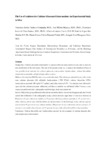The use of antidotes for calcium gluconate extravasation: an experimental study in mice

Ver/
Use este enlace para citar
http://hdl.handle.net/2183/30658Coleccións
- Investigación (FCS) [1295]
Metadatos
Mostrar o rexistro completo do ítemTítulo
The use of antidotes for calcium gluconate extravasation: an experimental study in miceAutor(es)
Data
2018Cita bibliográfica
Pacheco Compaña FJ, Midón Míguez J, de Toro Santos FJ, Centeno Cortés A, López San Martín P, Yebra-Pimentel Vidal MT, Mosquera Osés JJ. The use of antidotes for calcium gluconate extravasation: an experimental study in mice. Plast Reconstr Surg. 2018 Sep;142(3):699-707.
Resumo
[Abstract] Background: Calcium gluconate extravasation is a process that can cause serious lesions, such as necrosis and calcification of the soft tissues. The aim of the present study was to analyze the beneficial effects of four possible local antidotes for calcium gluconate extravasation: hyaluronidase, sodium thiosulfate, triamcinolone acetonide, and physiologic saline solution.
Methods: Seventy-four BALB/c mice were used in the study. The substances selected for use in this study were calcium gluconate (4.6 mEq/ml), hyaluronidase (1500 IU/ml), sodium thiosulfate (25%), triamcinolone acetonide (40 mg/ml 0.5 mg/kg), and saline solution 0.9%. Five minutes were allowed to lapse after the calcium gluconate infiltration, and then an antidote was infiltrated. After 3 weeks, a skin biopsy was performed and a radiographic and histologic study was carried out.
Results: Only in the group infiltrated with sodium thiosulfate did all skin lesions disappear after the 3-week period after infiltration. In the radiographic study, calcium deposits larger than 0.5 mm were observed in 40 percent of cases without an antidote, in 33 percent with triamcinolone acetonide, in 13 percent with a saline solution, and in none with thiosulfate and hyaluronidase. In the histologic study, calcium deposits were found in 53 percent of cases without antidote, 100 percent of cases with triamcinolone acetonide, 33 percent of cases with saline solution, and 13 percent of cases with sodium thiosulfate or hyaluronidase.
Conclusion: Sodium thiosulfate and hyaluronidase prevent the development of calcium deposits after calcium gluconate extravasation.
Palabras chave
Antidotes
Calcinosis
Calcium gluconate
Skin diseases
Calcinosis
Calcium gluconate
Skin diseases
Versión do editor
ISSN
0032-1052





